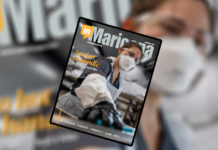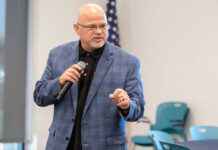
inmaricopa.com runs, on a regular basis, opinion pieces submitted by community members. The following article is the opinion of the author, and does not necessarily reflect the views of inmaricopa.com.
Timothy Egan in his book, “The Worst Hard Times,” describing the Dust Bowl drought of the 1930s, and one of the worst environmental disasters of the 20th century, likened it to “…(the) interplay of politics, money, environmental forces, and the gamut of human motivations.” Understanding what occurred then is critical to understanding the fugitive dust emissions that we are experiencing in Maricopa. It’s apparent that all of us own this problem.
Dust storms are a predictable part of living here. Whether the accumulation of dust during a storm is from the dry agricultural fields, new developments, surrounding desert dirt/sand, ATVs, horse corrals, frequently or used dirt roads, they all create dust problems and make it inherently difficult to manage the National Ambient Air Quality Standard (NAAQS) rules. There will always be particulate matter.
NAAQS has separated particulate matter into two groups: PM2.5 (particles that are 2.5 microns or smaller in diameter) and PM10 (particles between 0 and 10 microns in size). For example, the principal cause for decreased visibility according to The Greater Phoenix Regional Atlas is linked to PM2.5, whereas PM10 is associated with health-based standards, but the jury is still out on whether there is sufficient data at this time to decide what changes should be made to the PM10 standards.
Where air pollution levels persistently exceed NAAQS parameters or contribute to ambient air quality, by failing to meet standards, the area can be designated as “nonattainment” by the Environmental Protection Agency. Normally, the EPA takes this action only after air quality standards have been exceeded for several consecutive years.
At one point in 2006, the EPA considered revoking PM10 urban and rural standard measurements and is still dancing around the issue. Pinal County recognized the EPA’s waffling on this important matter and organized the first Particulate Matter Stakeholder Process meeting in 2007; again in 2008, and it will be repeated on Friday, April 17, 2009 in Florence at 9:30 a.m., Pinal County Emergency Operations Center, Building F, 31 N. Pinal St. This will provide for continued dialogue toward healthful air quality in Maricopa and Pinal County.
Pinal County has not been consistently active in building infrastructure, such as paving, gravelling, or oiling roads around the back country or creating stringent dust regulations. In the past, builders advertised that it was cheaper and easier to build in Pinal County because of fewer regulations.
Pinal is no different from most other counties that face denials for funding requests and shortfalls, as do most air quality agencies. We all own this problem and must bear the costs associated with it. Regulating the various sources can be difficult and make quality problems inherently difficult to manage. Nobody wants to be regulated!
What can be done to get fugitive dust out of Maricopa? The Maricopa Planning and Zoning Commission could begin insisting developers include dust control measures in their plans. Maybe the city should allow tax abatements for developers willing to plant grasses or legumes on their current sprawling undeveloped land tracts. Control strategies already developed for farmlands needs to be taken seriously.
Statistics support dust generation data, indicating transportation contributes to four of the six criteria pollutants. This provides Maricopa’s Public Works Division the opportunity to devise strategies in Maricopa for dust control. Citizens should become familiar with “Tips for Citizens” at Pinal County’s Air Quality Web site. To report a dust problem, call 520-866-6929.
It takes all of us, including the city of Maricopa and Pinal County government, working together to help produce a safe environment. Dust control is a collaborative process. All reasonable precautions must be taken to prevent particulate matter from becoming airborne. Call the Pinal County Board of Supervisors and the city of Maricopa and tell them you have had it with fugitive dust and want it to stay where it belongs – on the ground.
Carpe Diem Maricopa!
Dr. Hull is a Sustainability Systems Activist, member of the Environmental Concerns Organization (ECO), Inc.; member of International Dark-Sky Association (IDA); member of Arizona Recycling Coalition Legislative Committee; the founder of SOS Maricopa and a graduate of the first city of Maricopa Citizen’s Leadership Academy.
Photo courtesy of the Environmental Protection Agency









![City gave new manager big low-interest home loan City Manager Ben Bitter speaks during a Chamber of Commerce event at Global Water Resources on April 11, 2024. Bitter discussed the current state of economic development in Maricopa, as well as hinting at lowering property tax rates again. [Monica D. Spencer]](https://www.inmaricopa.com/wp-content/uploads/2024/04/spencer-041124-ben-bitter-chamber-property-taxes-web-218x150.jpg)
![Maricopa restaurateur makes Food Network connection [Namkeen Dhaba]](https://www.inmaricopa.com/wp-content/uploads/2024/04/439456716_377105198650519_7536248579664805896_n-218x150.jpg)

![O’Reilly gears up for second Maricopa location An exterior view of O'Reilly Auto Parts on John Wayne Parkway on May 2, 2024.[Monica D. Spencer]](https://www.inmaricopa.com/wp-content/uploads/2024/05/spencer-050224-oreilly-second-location-web-100x70.jpg)
![Province writer opens the athlete’s mind in new book Tom Schuman, a Province resident, poses with a copy of his new book, "My Wide World of Sports," outside his home on May 2, 2024. [Monica D. Spencer]](https://www.inmaricopa.com/wp-content/uploads/2024/05/spencer-050224-tom-schuman-sports-book-web-01-100x70.jpg)

